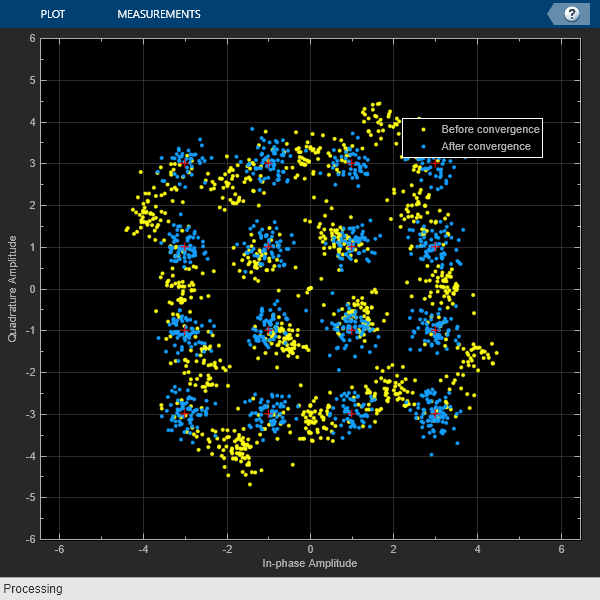comm.CarrierSynchronizer
Compensate for carrier frequency offset
Description
Thecomm.CarrierSynchronizerSystem object™ compensates for carrier frequency and phase offsets in signals that use single-carrier modulation schemes. The carrier synchronizer algorithm is compatible with BPSK, QPSK, OQPSK, 8-PSK, PAM, and rectangular QAM modulation schemes.
Note
This System object does not resolve phase ambiguities created by the synchronization algorithm. As indicated in this table, the potential phase ambiguity introduced by the synchronizer depends on the modulation type:
Modulation Phase Ambiguity (degrees) 'BPSK'or'PAM'0, 180 'OQPSK','QPSK', or'QAM'0, 90, 180, 270 '8PSK'0, 45, 90, 135, 180, 225, 270, 315 TheExamplesdemonstrate carrier synchronization and resolution of phase ambiguity.
For best results, apply carrier synchronization to non-oversampled signals, as demonstrated inCorrect Phase and Frequency Offset for 16-QAM Using Coarse and Fine Synchronization。
To compensate for frequency and phase offsets in signals that use single-carrier modulation schemes:
Create the
comm.CarrierSynchronizerobject and set its properties.Call the object, as if it were a function.
To learn more about how System objects work, seeWhat Are System Objects?。
Creation
Description
carrSynch= comm.CarrierSynchronizer
carrSynch= comm.CarrierSynchronizer(Name,Value)
Properties
Usage
Description
Input Arguments
Output Arguments
Object Functions
To use an object function, specify the System object as the first input argument. For example, to release system resources of a System object namedobj, use this syntax:
release(obj)
Examples
Algorithms
Thecomm.CarrierSynchronizerSystem object is a closed-loop compensator that uses the PLL-based algorithm described in[1]。同步器的输出,yn, is a frequency-shifted version of the complex input signal,xn, for the nth sample. The synchronizer output is
whereλnis the output of the direct digital synthesizer (DDS). The DDS is the discrete-time version of a voltage-controlled oscillator and is a core component of discrete-time phase locked loops. In the context of this System object, the DDS works as an integration filter.

To correct for the frequency offset, first the algorithm determines the phase error,en。The value of the phase error depends on the modulation scheme.
| Modulation | Phase Error |
|---|---|
| QAM or QPSK |
For a detailed description of this equation, see[1]。 |
| BPSK or PAM |
For a detailed description of this equation, see[1]。 |
| 8-PSK |
For a detailed description of this equation, see[2]。 |
| OQPSK |
|
To ensure system stability, the phase error passes through a biquadratic loop filter governed by
whereψnis the output of the loop filter at sample n, andgIis the integrator gain. The integrator gain is determined from the equation
whereθ,d,K0, andKpare determined from the System object properties. Specifically,
whereBnis the normalized loop bandwidth, andζis the damping factor. The phase recovery gain,K0, is equal to the number of samples per symbol. The modulation type determines the phase error detector gain,Kp。
| Modulation | Kp |
|---|---|
| BPSK, PAM, QAM, QPSK, or OQPSK | 2 |
| 8-PSK | 1 |
The output of the loop filter is then passed to the DDS. The DDS is another biquadratic loop filter whose expression is based on the forward Euler integration rule
wheregPis the proportional gain that is expressed as
Theinfoobject function of this System object returns estimates of the normalized pull-in range, the maximum frequency lock delay, and the maximum phase lock delay. The normalized pull-in range,(Δf)pull-in, is expressed in radians and estimated as
The expression for(Δf)pull-inbecomes less accurate as approaches 1.
The maximum frequency lock delay,TFL, and phase lock delay,TPL, are expressed in samples and estimated as
References
[1] Rice, M.Digital Communications: A Discrete-Time Approach。Upper Saddle River, NJ: Prentice Hall, 2009, pp. 359–393.
[2] Zhijie, H., Y. Zhiqiang, Z. Ming, and W. Kuang. “8PSK Demodulation for New Generation DVB-S2.”2004 International Conference on Communications, Circuits and Systems.Vol. 2, 2004, pp. 1447–1450.







